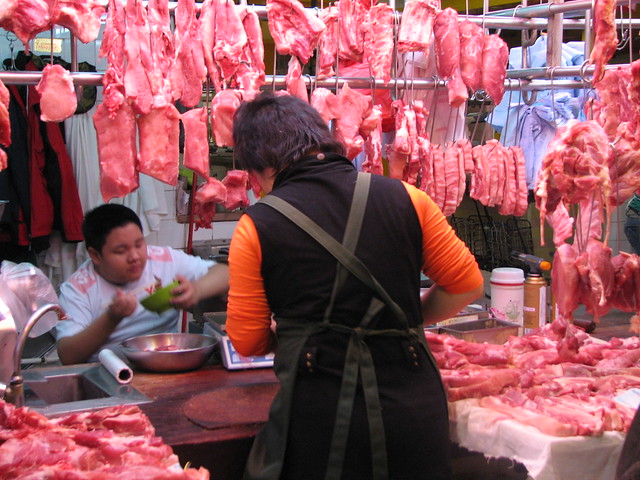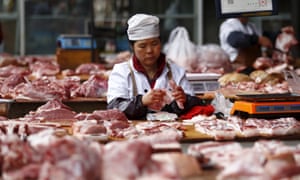http://e-info.org.tw/node/116590
你還無肉不歡嗎? 強國飲食新計畫 要減少肉食50%
文字大小
83 1 Share1
本報2016年6月24日綜合外電報導,姜唯編譯;蔡麗伶審校
中國衛生部公布最新《中國居民膳食指南》,提出減少國民食用肉品量50%,建議13億中國國民每人每天食用40至75克的肉品,以促進健康並減少溫室氣體排放。
對中國人而言,肉不再是奢侈品。圖片來源:Shawn Carson(CC BY-NC-ND 2.0)。
富裕國家愛吃肉 中國新富階級也將「跟上」
若能遵守這份指南,中國畜牧業排放的二氧化碳到2030年可望減少10億噸,該年的排放量預計將減至18億噸。
對中國人而言,肉品已從過去的奢侈品變成日常主食。1982年,平均每個中國人一年只吃13公斤的肉,而牛肉更是有錢人才吃得起的珍稀肉品。中國成為全球經濟強權之一後,新富階級國民的飲食習慣大幅改變,現在每個中國人每年要吃63公斤的肉。照此成長速度,到了2030年,中國每人每年會吃掉93公斤的肉。新的指南則可減少至每人每年14至27公斤。
目前中國消耗全球28%的肉,包括半數的豬肉,不過人均肉食量仍落後世界上數十國,像澳洲和美國的人均肉食量都是中國的兩倍。
台灣人均肉食攝取也不低。根據台灣動物社會研究會去(2015)年調查,按照衛福部《每日飲食指南》建議,國人每日豆魚肉蛋建議分量約三~八份,若以每日二份(每份35克)肉類換算,全台每年約22.04~58.77萬公噸,然而,去(2014)年台灣光是豬肉屠體總重就高達82萬噸,顯示國人肉食額度超量。
國際智庫:暖化控制2°C內 飲食習慣必改變
全球目前有14.5%的溫室氣體排放量來自畜牧業,比運輸業還高。除了牲畜排放強力溫室氣體甲烷,砍伐森林和施肥也會釋放大量的碳。
根據非政府組織「野生救援」(WildAid)的報告,中國肉食成長預計每年多釋放2億3300萬噸溫室氣體,同時使中國面臨污染、乾涸的水資源更加緊繃。
報告警告,中國肉食消耗若不受到控制,將會導致耕地劣化,肥胖和糖尿病等問題更加嚴重。根據估計,約有1億中國人罹患糖尿病,遠高於其他國家。
智庫皇家國際事務研究所2014年發表的研究預測,2020年中國一個國家就會吃掉超過2000萬噸的肉、乳製品。該智庫也警告,若要控制暖化在2°C以內,飲食習慣的改變是必要措施。
牛津大學馬丁學院(Oxford Martin School)今年最新的研究也發現,若全世界能普遍地實行素食,將能減少2/3的溫室氣體排放。
China's plan to cut meat consumption by 50% cheered by climate campaigners
New dietary guidelines could reduce greenhouse gas emissions by 1bn tonnes by 2030, and could lessen country’s problems with obesity and diabetes
The Chinese government has outlined a plan to reduce its citizens’ meat consumption by 50%, in a move that climate campaigners hope will provide major heft in the effort to avoid runaway global warming.
New dietary guidelines drawn up by China’s health ministry recommend that the nation’s 1.3 billion population should consume between 40g to 75g of meat per person each day. The measures, released once every 10 years, are designed to improve public health but could also provide a significant cut to greenhouse gas emissions.
The Chinese Communist party has found unusual allies among Hollywood celebrities, with actor Arnold Schwarzenegger and director James Cameron involved in a series of new public information adverts encouraging Chinese people to consume less animal flesh to help the environment.
Should the new guidelines be followed, carbon dioxide equivalent emissions from China’s livestock industry would be reduced by 1bn tonnes by 2030, from a projected 1.8bn tonnes in that year.
Globally, 14.5% of planet-warming emissions emanate from the keeping and eating of cows, chickens, pigs and other animals – more than the emissions from the entire transport sector. Livestock emit methane, a highly potent greenhouse gas, while land clearing and fertilizers release large quantities of carbon.
“Through this kind of lifestyle change, it is expected that the livestock industry will transform and carbon emissions will be reduced,” said Li Junfeng, director general of China’s National Center on Climate Change Strategy and International Cooperation.
“Tackling climate change involves scientific judgement, political decisions, entrepreneurial support, but at last, it still relies on involvement of the general public to change the consumption behavior in China. Every single one of us has to believe in the low-carbon concept and slowly adapt to it.”
Meat has gone from rare treat to a regular staplefor many Chinese people. In 1982, the average Chinese person ate just 13kg of meat a year and beef was nicknamed “millionaire’s meat” due to its scarcity.
The emergence of China as a global economic power has radically altered the diets of a newly wealthy population. The average Chinese person now eats 63kg of meat a year, with a further 30kg of meat per person expected to be added by 2030 if nothing is done to disrupt this trend. The new guidelines would reduce this to 14kg to 27kg a year.
China now consumes 28% of the world’s meat, including half of its pork. However, China still lags behindmore than a dozen other countries in per capita meat consumption, with the average American or Australian consuming twice as much meat per person compared to China.
According to a new report by WildAid, the predicted increase in China’s meat consumption would add an extra 233m tonnes of greenhouse gases to the atmosphere each year, as well as put increased strain on the country’s water supply, which is already blighted by polluted and denuded rivers and groundwater.
The report warns that unchecked Chinese meat consumption will also degrade its arable land and worsen the country’s problems with obesity and diabetes. An estimated 100 million Chinese people have diabetes, more than any other country.
Research released by the thinktank Chatham House in 2014 forecast that China alone is expected to eat 20m tonnes more of meat and dairy a year by 2020 and warned that “dietary change is essential” if global warming is to not exceed the 2C limit eventually imposed at the climate accord in Paris last year.
A separate report by scientists at the Oxford Martin School this year found that the widespread adoption of vegetarianism around the world could bring down greenhouse gas emissions by nearly two-thirds.
“China’s move to cut meat consumption in half would not only have a huge impact on public health, it is a massive leadership step towards drastically reducing carbon emissions and reaching the goals set out in the Paris agreement,” said James Cameron.
“Animal agriculture emits more than all transportation combined. Reducing demand for animal-based foods is essential if we are to limit global warming to 2C as agreed at COP21.”
Despite the Chinese government’s new commitment to reducing meat consumption, it may be difficult to convince the country’s rising middle classes to cut down. There are also strong cultural traditions attached to the eating of many animals, especially pigs. The Chinese character for “home” depicts a pig underneath the roof of a house.
Recently, Chinese companies have been buying farms in the United States and Australia to provide feed for the country’s dairy and beef industries.
In late 2013 a Chinese company, Shenghui, purchased the largest US pork producer, Smithfield Foods, to help keep up with demand.
“China’s consumption of meat is skyrocketing,” said Jeremy Haft, an adjunct professor at Georgetown University in Washington, DC and author of a 2015 book, “Unmade in China: The Hidden Truth about China’s Economic Miracle.”
“China’s demand for meat will continue to grow and support hundreds of thousands of jobs in the US meat industry,” he added. “From a climate perspective, the methane will still be created, but will be shifted to the United States.”
In late 2013 a Chinese company, Shenghui, purchased the largest US pork producer, Smithfield Foods, to help keep up with demand.
“China’s consumption of meat is skyrocketing,” said Jeremy Haft, an adjunct professor at Georgetown University in Washington, DC and author of a 2015 book, “Unmade in China: The Hidden Truth about China’s Economic Miracle.”
“China’s demand for meat will continue to grow and support hundreds of thousands of jobs in the US meat industry,” he added. “From a climate perspective, the methane will still be created, but will be shifted to the United States.”



沒有留言:
張貼留言